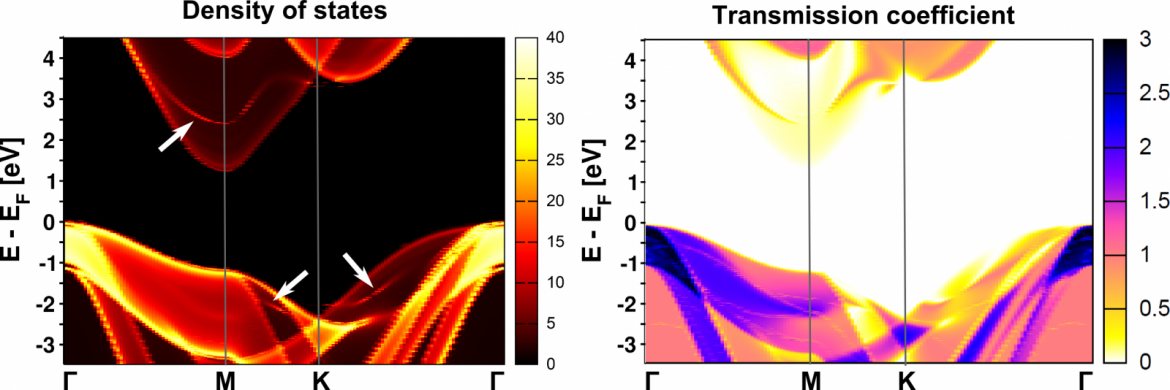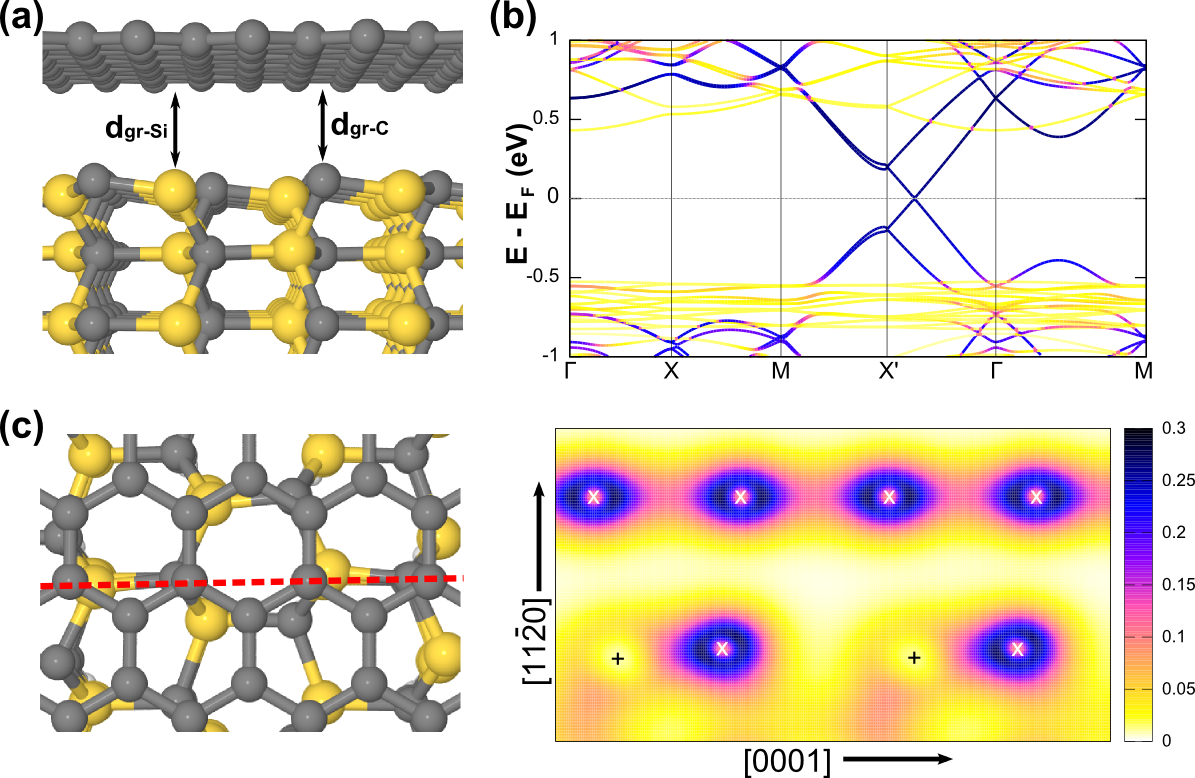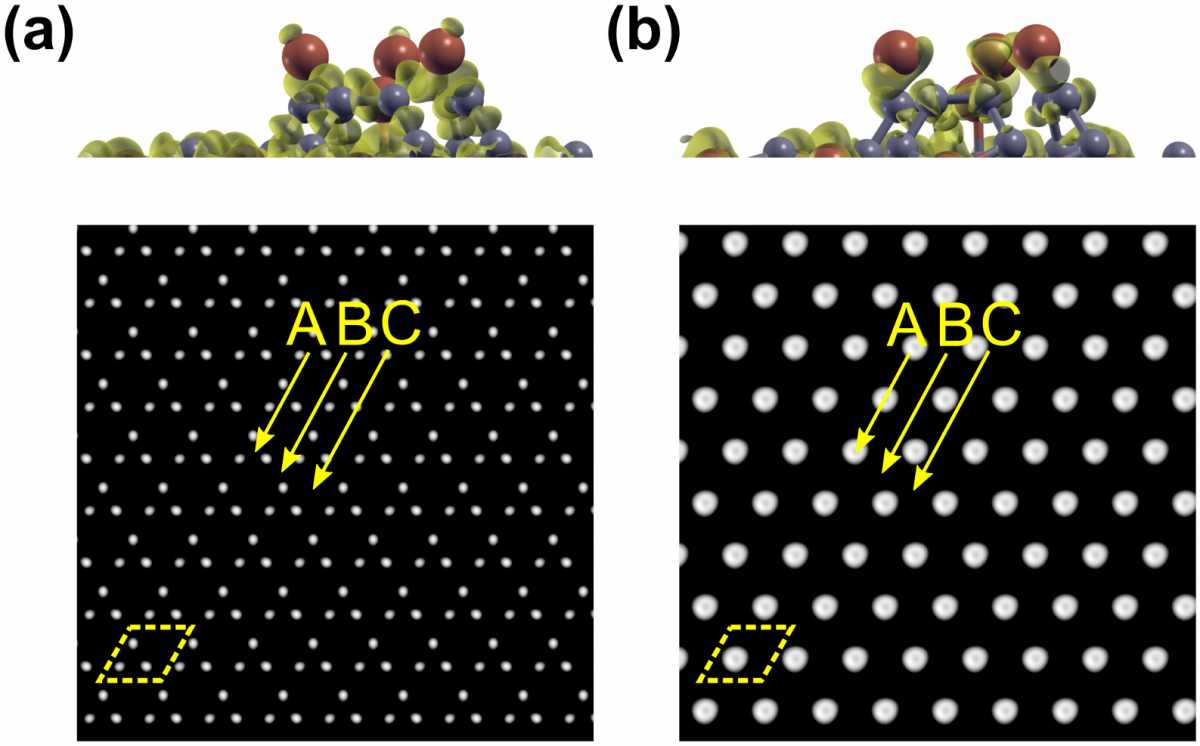
The theoretical-computational activity at Catania HQ aims at bridging the gap between the atomic and quantum phenomena that rule interactions and processes at the nanoscale with the macroscopic dimensions of real materials, devices and applications. To this purpose, several complementary approaches are developed and employed, starting from a quantum mechanical description of materials and devices with an atomic resolution, all the way up to the realization of advanced algorithms for the simulation of real-world processes and devices within Continuum and Kinetic Monte Carlo (KMC) methodologies. The research fields of interest are vast and include the structural prediction, electronic configuration, device simulation, quantum transport, atomic diffusion and kinetics, process simulation, advanced numerical modelling and simulation of experimental techniques. The studied materials range from nanostructured and low-dimensional to thin films and wafers.
Structural and electronic properties of materials from first principles calculations
A wide range of macroscopic phenomena regarding the electrical, optical and thermal characteristics of materials have often a microscopic origin that can be traced at the electronic and structural configuration of single atoms. We use the density functional theory to address as series of atomistic problems that include the energetics of defects, surfaces and interfaces, the diffusion barriers of adatoms, the electronic properties of complex systems and the atomic configuration of locally perturbed structures. The application area covers two-dimensional materials (graphene, transition metal chalcogenides, phosphorene), hybrid organic-inorganic perovskites and wide bandgap semiconductors.


Figure 1: Structural and electronic characteristic of graphene on a SiC(11-20) surface.
Reference person: Ioannis Deretzis
Projects:
1. Graphene heterostructures with Nitrides for high frequency Electronics (Granite). E.U. Project. Funding agency: MIUR in the framework of the European program "FET Flagship ERA-NET" (FLAG-ERA)
Collaborations: CNR-Nano, University of Catania
Software: Quantum Espresso, SIESTA, Wien2K
Publications:
1. I. Deretzis, E. Smecca, G. Mannino, A. La Magna, T Miyasaka, A. Alberti, Journal of Physical Chemistry Letters 9, 3000 (2018)
2. G. Nicotra, Q. M. Ramasse, I. Deretzis, A. La Magna, C. Spinella, F. Giannazzo, ACS Nano 7, 3045-3052 (2013)
3. I. Deretzis, A. La Magna. Nanoscale 9, 5896-5903 (2017)
4. I. Deretzis, A. Alberti, G. Pellegrino, E. Smecca, F. Giannazzo, N. Sakai, T. Miyasaka, A. La Magna, Applied Physics Letters 106, 131904 (2015)
Electron and phonon transport in nanoscale devices
As the miniaturization trend for electrical devices has nowadays reached the nanoscale, simulation techniques are expected to fully take into account quantum effects introduced by confinement, chemical interactions and defects. We use appropriate formalisms based on Green functions for the calculation of quantum transport in multi-terminal devices in the presence of point and extended defects, interacting with substrates and metallic contacts. Advanced numerical techniques are applied for the simulation of devices that are comparable to experiments. We simulate phonon transport with advanced continuum modelling based on finite element methodologies that interpolate the ballistic and diffusive limits, allowing computations in complex systems.


Figure 2: Transmission probability as a function of energy and real-space band for a metal-graphene nanoribbon junction.
Reference person: Antonino La Magna
Projects:
1. Wide band gap Innovative SiC for Advanced Power (WInSiC4AP). E.U Project. Funding agency: ECSEL Joint Undertaking and ESI.
Collaborations: SCREEN-LASSE, University of Catania
Software: In-house codes based on nonequilibrium Green’s functions, Finite elements methods based on the Fenics libraries.
Publications:
1. I. Deretzis, G. Fiori, G. Iannaccone, A. La Magna, Physical Review B 81, 085427 (2010)
2. F. Giannazzo, I. Deretzis, A. La Magna, F. Roccaforte, R. Yakimova, Physical Review B 86, 235422 (2012)
3. I. Deretzis, M. Camarda, F. La Via, A. La Magna, Physical Review B 85, 235310 (2012)
4. L. Parisi, G.G.N. Angilella, I. Deretzis, R. Pucci, A. La Magna, Condensed Matter 2 (4), 37 (2017)
Process simulation from the meso- to the macro-scale
Actual processes for the growth and manipulation of materials usually have time scales that range from minutes to hours. Such temporal extension intrinsically limits the possibility to use ab initio or classical kinetic models for the simulation of the process evolution. We develop atomistic (KMC) and continuum approaches that overcome such limitation by combining in-house and commercial software tools. Within a multiscale perspective, we simulate kinetic growth and manipulation (e.g. growth of epitaxial graphene on SiC and hydrogen intercalation) and thermally activated processes (e.g. laser annealing and the induced atom diffusion). The activity involves strong collaboration with commercial partners.


Figure 3: Simulation of the process of hydrogen intercalation for epitaxial graphene grown on SiC(0001)
Reference person: Antonino La Magna
Projects:
1. 3C-SiCHetero-epitaxiALLy grown on silicon compliancE substrates and new 3C-SiC substrates for sustaiNable wide-band-Gap powEr devices (CHALLENGE), E.U. HORIZON 2020 project. Funding agency: European Commission
2. Graphene heterostructures with Nitrides for high frequency Electronics (Granite). E.U. Project. Funding agency: MIUR in the framework of the European program "FET Flagship ERA-NET" (FLAG-ERA)
Collaborations: SCREEN-LASSE, CNRS
Software: In-house codes based on advanced kinetic Monte Carlo methodologies, Finite elements methods based on the Fenics libraries, Comsol Multiphysics
Publications:
1. I Deretzis, A La Magna, Nanoscale 5, 671-680 (2013)
2. I. Deretzis, B.N. Di Mauro, A. Alberti, G. Pellegrino, E. Smecca, A. La Magna. Scientific Reports 6, 24443 (2016)
3. I Deretzis, A. La Magna, Physical Review E 93, 033304 (2016)
4. S. F. Lombardo, S. Boninelli, F. Cristiano, I. Deretzis, M. G. Grimaldi, K. Huet, E. Napolitani, A. La Magna, Journal of Applied Physics 123, 105105 (2018)
Simulation of experimental techniques
A series of characterization techniques often necessitate an adequate theoretical/computational background in order to correctly interpret the experimental results. We develop and apply advanced numerical modelling schemes in order to simulate widespread experimental techniques. Examples include the simulation of angle-resolved photoemission spectroscopy (ARPES), electron energy loss spectroscopy (EELS) and scanning tunnelling microscopy (STM) for two-dimensional materials.


Figure 4: Simulation of scanning tunnelling microscopy for a reconstructed SiC(000-1) surface.
Reference person: Ioannis Deretzis
Projects:
1. Beyond NANO upgrade. Italian national project. Funding agency: Sicilian Region
2. Wide band gap Innovative SiC for Advanced Power (WInSiC4AP). E.U Project. Funding agency: ECSEL Joint Undertaking and ESI.
Collaborations: University of Catania
Software: Wien2K, In-house codes
Publications:
1. I. Deretzis, G. Calogero, G. G. N. Angilella, A La Magna, EPL (Europhysics Letters) 107, 27006 (2014)
2. D. D’Angelo, C. Bongiorno, M. Amato, I. Deretzis, A. La Magna, G. Compagnini, S. F. Spanò, S. Scalese, Carbon 93, 1034-1041 (2015)
3. F. Giannazzo, G. Fisichella, G. Greco, S. Di Franco, I. Deretzis, A. La Magna et al., ACS applied materials & interfaces 9, 23164-23174 (2017)
4. I. Deretzis, A. La Magna, Applied Physics Letters 102, 093101 (2013)
Hardware list at Catania HQ
1. Server with 8 Intel Xeon CPUs (3.00 GHz), RAM 46 Gb
2. Server with 16 Intel Xeon CPUs (2.00 GHz), RAM 206 Gb
3. IBM BladeCenter, 7 nodes, 104 total CPUs, RAM 46 Gb per node
Catania HQ reference person: Ioannis Deretzis


